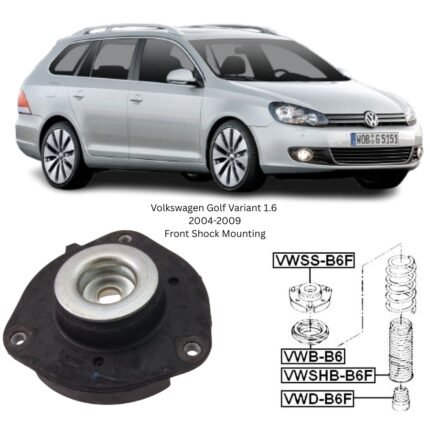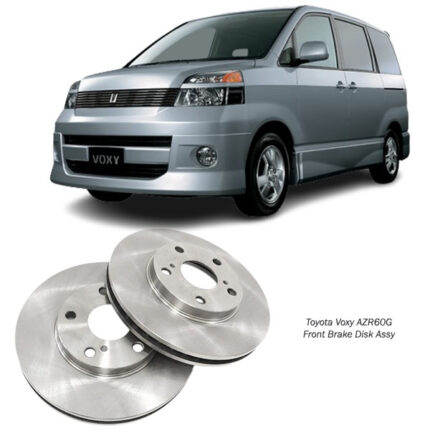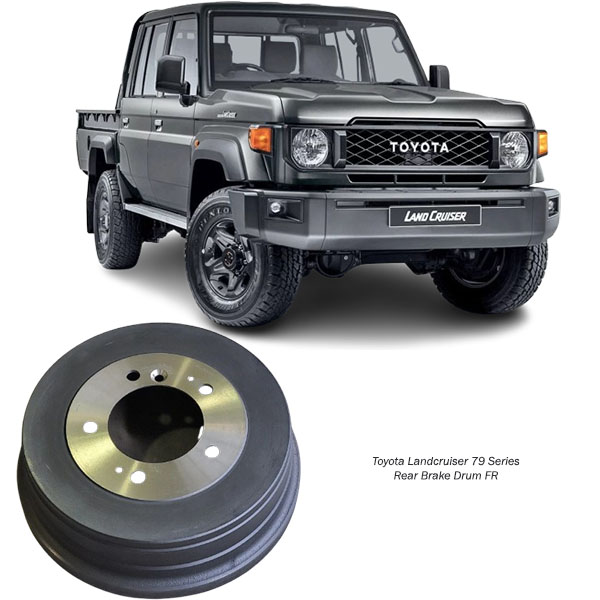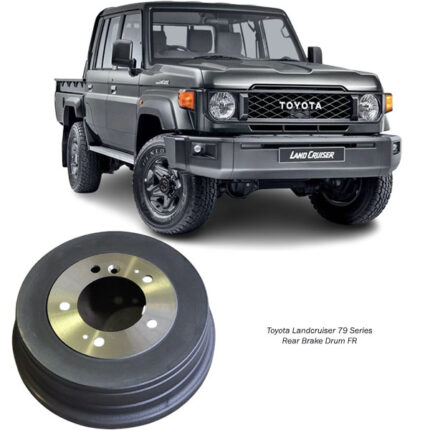Get Toyota Landcruiser 79 Series Rear Brake Drum 42431-60250 in Kenya
The brake drum is a critical component in many automotive braking systems, particularly in older vehicles and certain modern applications like trucks and trailers. This cylindrical part works in conjunction with brake shoes to slow down and stop a vehicle by converting kinetic energy into heat through friction. Understanding the brake drum’s function, construction, advantages, and limitations provides valuable insight into automotive engineering and maintenance.
1. Function and Operation
The brake drum is a hollow, cylindrical component that rotates with the wheel. Inside the drum, there are brake shoes that press against its inner surface to create friction, which slows down the wheel’s rotation. When the driver presses the brake pedal, hydraulic pressure from the master cylinder pushes the brake shoes outward against the drum. The friction generated between the shoes and the drum surface converts the vehicle’s kinetic energy into heat, slowing the vehicle down.
2. Construction and Materials
Brake drums are typically made from cast iron due to its excellent wear resistance and ability to withstand high temperatures. However, some high-performance applications may use composite materials to reduce weight and improve heat dissipation. The drum’s interior surface, where the brake shoes make contact, is machined to a smooth finish to ensure consistent friction and even wear.
The basic components of a drum brake system include:
- Brake Drum: The rotating component that the shoes press against.
- Brake Shoes: Curved friction material that presses against the drum.
- Wheel Cylinder: Contains pistons that push the brake shoes outward when hydraulic pressure is applied.
- Return Springs: Pull the brake shoes back to their resting position when the brake pedal is released.
- Backing Plate: Supports all the components and attaches to the vehicle’s axle.
3. Types of Brake Drums
There are two main types of brake drums:
- Leading-Trailing Drum Brake: This system uses a single leading shoe and a trailing shoe. The leading shoe is pushed into the drum in the direction of rotation, providing more braking force. The trailing shoe is pushed in the opposite direction, offering less braking force. This design is simple and cost-effective but provides less braking power compared to duo-servo systems.
- Duo-Servo Drum Brake: This type uses two leading shoes that are both self-energizing, meaning they are pulled into the drum by the drum’s rotation, increasing braking force. Duo-servo brakes provide more stopping power and are commonly used in heavier vehicles like trucks and trailers.
4. Advantages of Brake Drums
1. Durability and Longevity
Brake drums are known for their durability and long service life. This is primarily due to the materials used in their construction, typically cast iron or composite materials, which can withstand substantial wear and tear. The robust nature of brake drums makes them particularly suited for heavy-duty vehicles like trucks, trailers, and buses, where the braking system is subjected to high levels of stress and frequent use.
2. Cost-Effectiveness
Brake drums are generally less expensive to manufacture and maintain compared to disc brakes. The production process for brake drums is simpler, and the materials used are less costly. Additionally, the maintenance and replacement parts, such as brake shoes, are usually more affordable than disc brake pads and rotors. This cost advantage makes brake drums an attractive option for budget-conscious consumers and fleet operators.
3. Effective in Lower Speed Applications
In situations where vehicles operate at lower speeds and do not require the high-performance characteristics of disc brakes, brake drums provide adequate and reliable braking. For example, many smaller cars, older vehicles, and certain commercial vehicles use drum brakes on the rear axle. The braking force required in these applications is well within the capability of drum brakes, making them a suitable and economical choice.
4. Integration of Parking Brake Mechanism
One of the notable advantages of brake drums is their ability to easily incorporate a mechanical parking brake mechanism. The design of drum brakes allows for a straightforward addition of a parking brake lever and cable system, which can lock the brake shoes against the drum, preventing the vehicle from rolling. This integration is more complex and costly in disc brake systems, which often require a separate mechanism or an additional caliper.
5. Simplicity and Reliability
The simple design of drum brakes contributes to their reliability. With fewer components exposed to the environment compared to disc brakes, drum brakes are less susceptible to damage from debris and contaminants. This simplicity also translates to easier maintenance and repairs, as the components are more accessible and straightforward to service. In many cases, drum brakes can be adjusted manually to compensate for wear, ensuring consistent performance over time.
6. Self-Energizing Effect
Brake drums can leverage a self-energizing effect, where the rotation of the drum assists in pressing the brake shoes more firmly against the drum’s surface. This phenomenon occurs because the leading shoe in the brake drum is pulled into the drum as it rotates, increasing the braking force with less input pressure from the driver. This effect enhances braking efficiency and can be particularly beneficial in heavy-duty applications.
7. Heat Absorption and Dissipation
Although drum brakes are generally considered less effective at heat dissipation than disc brakes, they have a larger mass and surface area that can absorb significant amounts of heat. This heat capacity can be advantageous in certain applications, as it helps to prevent overheating during prolonged braking. Additionally, advancements in drum brake design and materials have improved their ability to manage and dissipate heat, reducing the risk of brake fade under extreme conditions.
8. Noise and Vibration Reduction
Brake drums can operate more quietly than disc brakes, especially when they are properly maintained and adjusted. The enclosed design of drum brakes helps to contain noise and vibration, leading to a smoother and quieter braking experience. This characteristic is particularly appreciated in passenger vehicles, where comfort and noise levels are important considerations.
9. Suitability for Rear Axle Braking
In many vehicles, especially those with front disc and rear drum brake configurations, the brake drums on the rear axle handle a smaller portion of the braking load. This distribution is because most of the braking force is needed at the front wheels, where disc brakes excel. In this context, brake drums are well-suited for the rear axle, providing adequate braking performance and integrating seamlessly with the vehicle’s overall braking system.
10. Less Prone to Contamination
The enclosed nature of drum brakes makes them less vulnerable to contamination from road debris, water, and mud compared to exposed disc brakes. This can be particularly beneficial in off-road and adverse weather conditions, where the braking components are more likely to be exposed to harsh environments. The reduced risk of contamination helps maintain consistent braking performance and reduces the likelihood of brake failure due to external factors.
5. Limitations of Brake Drums
- Heat Dissipation: Drum brakes are less efficient at dissipating heat compared to disc brakes. Excessive heat can lead to brake fade, where the brakes become less effective.
- Weight: Brake drums are generally heavier than disc brake components, which can negatively impact vehicle performance and fuel efficiency.
- Maintenance: While drum brakes are durable, they can be more challenging to inspect and service compared to disc brakes. Adjustments are often needed to maintain optimal performance.
- Performance: Drum brakes generally offer less stopping power and are more prone to fading under heavy use compared to modern disc brakes.
6. Modern Use and Applications
While many modern vehicles have shifted to disc brakes for their superior performance and heat dissipation capabilities, brake drums are still widely used in certain applications. They are commonly found on the rear wheels of some passenger cars, trucks, and trailers. Drum brakes are also prevalent in commercial vehicles and heavy-duty applications due to their durability and ability to integrate a parking brake mechanism easily.
7. Maintenance and Inspection
Regular maintenance of brake drums is crucial to ensure safe and reliable braking performance. Key maintenance tasks include:
- Inspection: Regularly check the brake drum’s surface for signs of wear, scoring, or cracking. Inspect the brake shoes for even wear and sufficient friction material.
- Adjustment: Ensure the brake shoes are properly adjusted to maintain the correct clearance with the drum. Automatic adjusters can help maintain this clearance but manual adjustment may be required in some systems.
- Cleaning: Keep the brake assembly clean to prevent dust and debris from affecting performance. Use brake cleaner to remove contaminants from the drum and shoes.
- Replacement: Replace worn or damaged brake drums and shoes to maintain optimal braking performance. Brake drums may need to be machined or “turned” to restore a smooth surface if they become scored.
8. Future Trends
Advancements in materials and manufacturing processes continue to improve the performance and longevity of brake drums. The integration of composite materials and innovative designs can enhance heat dissipation and reduce weight. Additionally, electronic control systems are being developed to optimize braking performance and adjust brake force distribution dynamically, further extending the relevance of drum brakes in modern automotive engineering.
Follow us on Facebook for more parts.




